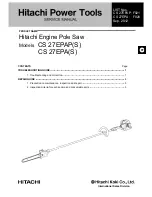
28 • ENGLISH
► Place the switch in the
OFF
position, remove the switch
key from the switch assembly. Store key in a safe place.
Choice of Blade and Speed
The scroll saw accepts a wide variety of blade widths and
thicknesses for cutting wood and other fibrous materials.
Your saw uses 5 in. long blades of either the pin end
or the plain end style. The blade width and thickness
and the number of teeth per inch to use are determined
by the type of material and the size of the radius being cut.
Note:
As a general rule, always select narrow blades for
intricate curve cutting and wide blades for straight and large
curve cutting.
BLADE INFORMATION
► Scroll saw blades wear out and must be replaced frequently
for best cutting results. Scroll saw blades generally stay
sharp for 1/2 hour to 2 hours of cutting, depending on type
of material and speed of operation.
► In cutting wood, best results are achieved when cutting
wood less than one inch thick.
► When cutting wood thicker than one inch, the user must
guide the workpiece very slowly into the blade and take
extra care not to bend or twist the blade while cutting.
► When choosing a blade, carefully consider the following:
a.
Very fine, narrow blades should be used to scroll cut
in thin material 1/4 in. (6mm) thick or less.
b.
Most blade packages state the size or thickness and
type of material which that blade is intended to cut.
The package should also state the radius or size of
curve that can be cut with that blade size.
c.
Wider blades cannot cut curves as tight or as small
as thinner blades.
► Blades wear faster when:
a.
Cutting plywood, hardwood, and other laminates.
b.
Cutting material thicker than 3/4 in. (19mm).
c.
Side pressure is applied to the blade.
Using Variable Speed (Fig. I)
► By turning the variable speed knob, the saw's speed may
be adjusted from a high speed of approximately 1600 SPM
(Strokes Per Minute) to a low speed of approximately
400 spm.
► To increase the strokes per minute, turn the variable speed
knob clockwise or to the right.
► To decrease the strokes per minute, turn the variable speed
knob counterclockwise or to the left.
Warning!
To avoid possible serious injury from accidental
starting, always turn the saw off, remove the switch key, and
unplug the saw from power source before removing or replac-
ing the blade.
Scroll Cutting
For general type scroll cutting, follow the pattern lines by
pushing and turning the workpiece at the same time. Do not
try to turn the workpiece while engaged in the blade without
pushing it – the workpiece could bind or twist the blade.
Warning!
To prevent serious personal injury, never leave
the saw unattended until the blade has come to a complete stop.
Interior Scroll Cutting (Fig. J)
► One feature of a scroll saw is that it can be used to make
scroll cuts on the interior of a workpiece without breaking
or cutting through the edge or perimeter of the board.
► To make interior cuts in the workpiece, remove the scroll saw
blade as explained in the section on
“Installing Blades”.
► Drill a 1/4 in. (6mm) hole in the workpiece.
► Place the workpiece on the saw table with the drilled
hole over the access hole in the table.
► Install blade through the hole in the workpiece;
adjust the drop foot and blade tension.
► When finished making the interior scroll cuts, simply remove
the blade from the blade holders as described in the section
on
“Installing Blades”,
and remove the workpiece from
the saw table.
Stack Cutting (Fig. K)
After becoming well acquainted with your saw through practice
and experience, you may wish to try stack cutting. Stack
cutting may be used when several identical shapes need
to be cut. Several pieces of wood may be stacked on top
and secured to each other before cutting. The wood pieces
may be joined together by placing double sided tape between
each piece or by wrapping masking tape around the corners or
ends of the stacked wood. You must attach the stacked pieces
of wood to each other so they will move on the table as a single
piece of material.
Speed
Teeth/
Width
Thickness
or strokes
Material Cut
Inch
per minute
10
.110 in.
.020 in.
1200-1600 Popular size for
(2.8mm)
(0.5mm)
cutting hard and
soft woods 3/16 in.
(4.8mm) up to
2 in. (51mm)
Plastics, paper,
felt, bone, etc.
15
.110 in.
.020 in.
600-1200
Wood, plastics,
(2.8mm)
(0.5mm)
extremely thin cuts
on materials 3/32 in.
(2.4mm) to 1/2 in.
(13mm) thick.
18
.095 in.
.010 in.
400-600
For tight radius work
(2.4 mm)
(0.3 mm)
in thin materials
3/32 in. (2.4mm)
to 1/8 in. (3mm)
wood, veneer, bone,
fiber, ivory, plastic,
etc.



































